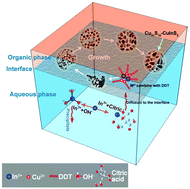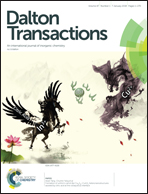Formation of uniform carrot-like Cu31S16–CuInS2 heteronanostructures assisted by citric acid at the oil/aqueous interface†
Abstract
A simple two-phase strategy was developed to prepare Cu31S16–CuInS2 heterostructures (HNS) at the oil/aqueous interface, in which the In(OH)3 phase was often obtained in the products due to the reaction between indium ions and hydroxyl ions in the aqueous phase. To prevent the formation of the In(OH)3 phase, citric acid was incorporated into the aqueous phase to assist in the synthesis of uniform carrot-like Cu31S16–CuInS2 semiconductor HNS at the oil/aqueous interface for the first time. By manipulating the dosage of citric acid and Cu/In precursor ratios, the morphology of the Cu31S16–CuInS2 HNS could be tailored from mushroom to carrot-like, and the presence of citric acid played a critical role in the synthesis of high-quality Cu31S16–CuInS2 HNS, which inhibited the formation of the In(OH)3 phase due to the formation of the indium(III)–citric acid complex. The formation mechanism was studied by monitoring the morphology and phase evolution of the Cu31S16–CuInS2 HNS with reaction time, which revealed that the Cu31S16 seeds were first formed and then the cation-exchange reaction directed the subsequent anisotropic growth of the Cu31S16–CuInS2 HNS.



 Please wait while we load your content...
Please wait while we load your content...